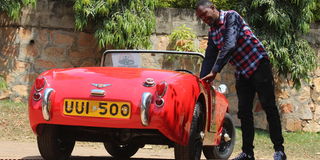Prime
Mbugua’s Austin-Healey Sprite rarely breaks down

The Austin-Healey Sprite’s body is one of the most durable there has ever been, and is still in the best mechanical shape with no cracks or dents. PHOTOs/Roland D. Nasasira
What you need to know:
Because Mbugua does not drive his car daily, it rarely breaks down. However, he does routine service, which includes replacing engine oil, spark plugs and air filters, among other parts.
A number of features strike you the moment you get up-close with the 65-year-old Austin Healey Sprite. If it is not its sharp and bright red colour, it is likely to be its six-character number plate, UUI 500 that forms part of the history of the car.
On the interior, its dashboard does not have many components but a speedometer, a manually turned on headlight switch, a fuel gauge, gear lever and handbrake, engine temperature gauge and a driving mirror, the size of a smartphone placed horizontally in the middle of the dashboard. It has no systems such as the air conditioner, or radio.
Unlike ordinary cars, when closely observed, the Austin Healey originally came with wire or knock-off wheels, with no studs onto which nuts rotate to lock the wheels. Technically, knock-off means that if you are to remove or replace any tyre in case of incidents such as a puncture when on the road, you instead knock the lock that tightens the wheels.
And instead of coming with a wheel spanner, the Austin Healey came with a soft rubber hammer to use when knocking off the wheel lock to avoid damaging or deforming it overtime. It was imported into Uganda as a brand new car, before it was owned by a foreign expatriate from whom James Mbugua, a vintage car enthusiast acquired it in 2022, making, him the third owner.
A 1958 model that could be the only one in Uganda, Mbugua says one unique thing about his car’s design is that it is typically an open roof, unlike convertibles whose roofs close and open with a press of a button. A roadster by classification, the two seater runs on a 1300cc petrol engine, with a full fuel tank capacity of 40 litres and a maximum speed of 180km/hr.
Maintenance
According to Mbugua, the Austin Healey rarely breaks down. It is one of the vintage vehicles whose durability basing on aspects such as the body and parts was not compromised.
“It has no major serviceable parts that are prone to wear and tear. All that is required is carrying out proper service that involves replacing engine oil and tyroid ends. The engine that uses four litres of oil rarely breaks down, as is the case with a number of modern cars. If there is a part to restore or replace, they are available online from the United Kingdom, eBay and Amazon, and other sites dealing in genuine vintage car parts,” Mbugua explains.
The fact that it is not a daily drive practically means that Mbugua takes quite long before visiting the garage. This also depends on the mileage covered. However, routine service includes replacing engine oil, spark plugs and air filters.
“The advantage of maintaining old cars is that their filters are serviceable. It just requires cleaning and I continue have to be replaced after 5,000km. It is a car I can service once a year because I do not drive it every day,” Mbugua adds.
Other features
Running on a four-speed manual transmission, on highways, particularly the Entebbe expressway, which is the longest route Mbugua has driven, the Austin Healey covers 14kms per litre of fuel. It has no trunk for carrying luggage but only comes with storage space at the rear that can be accessed by adjusting any of the seats.
It has bullet side mirrors, meaning that their front edge is in form of a bullet. These did not originally come with the car but are period-correct. This means that some enthusiasts restore vintage vehicles and improvise with much more modern parts on the car that did not originally belong to the particular car during their era. However, if the car had come out of the showroom in 1958, it would have come out with similar side mirrors.
“In terms of history preservation, a vehicle does not have to lose its identity in form of number plates because it is being sold or transferred from one owner to another. With vintage cars, the value of the car appreciates with its big number plates because they will never be printed again. They (big number plates) remain history for present and future generations,” Mbugua argues.
Performance
The Austin Healey, was in its days, a fast car, a performance feature it has maintained. This, however, comes with proper maintenance. It generates its wheel power from the rear wheels. Its body is one of the most durable there has ever been, and is still in the best mechanical shape with no cracks or dents. The car being small does not mean it is low. Its ground clearance is raised to allow you drive on any marrum or potholed road in Kampala City centre.
About
Invention
Austin-Healey got its start in 1952 by means of a partnership between two automakers; Austin, which was by then part of the British Motor Corporation conglomerate, and Donald Healey Motor Company. By the mid-1950s, Austin-Healey had plenty of success from sales of its 100-4 and 100-6, both front-engine, rear-drive, body-on-frame, two-door roadsters which were popular as road cars and as entry-level competition cars. Problem was, not everyone could afford the so-called «Big Healeys.» Austin boss Leonard Lord and Austin-Healey chief Donald Healey got together on an idea for a small, inexpensive sports car that would sell strongly in both European and American markets. The result was the first Austin-Healey Sprite.




